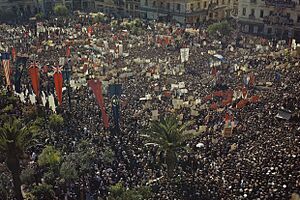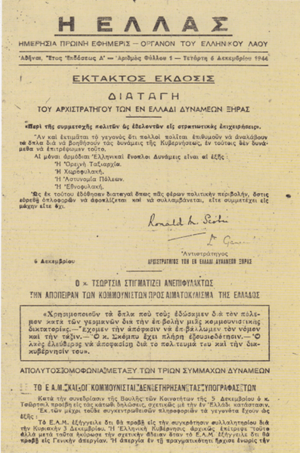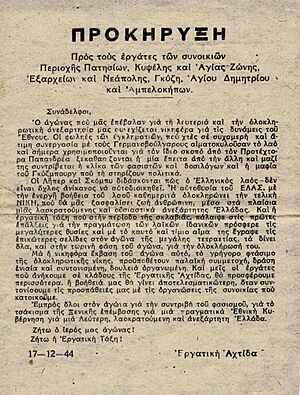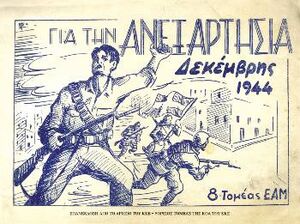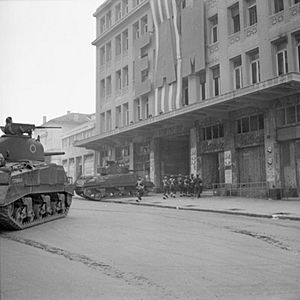Dekemvriana facts for kids
Quick facts for kids Dekemvriana |
|||||||
|---|---|---|---|---|---|---|---|
| Part of the Greek Civil War | |||||||
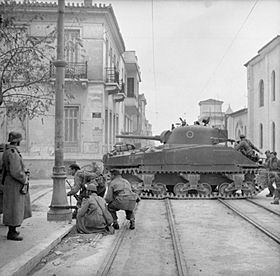 A Sherman tank and troops from the 5th (Scottish) Parachute Battalion, British 2nd Parachute Brigade together with their Greek allies, fighting against members of ELAS in Athens, 18 December 1944. |
|||||||
|
|||||||
| Belligerents | |||||||
|
|||||||
| Commanders and leaders | |||||||
| Strength | |||||||
(since 12-16 Dec. 1944) (since 18 Dec. 1944) |
|||||||
| Casualties and losses | |||||||
1,000 wounded 733 missing |
|||||||
The Dekemvriana (which means "December events" in Greek) was a series of intense fights in Athens, Greece. These clashes happened during World War II, from December 3, 1944, to January 11, 1945. It was a very difficult time for Greece.
The conflict was between two main groups. On one side was the communist EAM and its army, the ELAS. They were supported by the KKE. On the other side were the Greek government, parts of the Greek army, police forces, and the British Army.
Before these fights, different Greek groups had agreed to work together in a "Government of National Unity." They also agreed that all resistance groups would join the new Greek Army under British command. However, a British commander, General Ronald Scobie, ordered only EAM-ELAS to give up their weapons.
EAM leaders disagreed with this order. They resigned from the government and called for a large protest in Athens on December 3. About 200,000 people gathered. The Greek Police and Gendarmerie shot at the crowd, killing 28 protesters and injuring many more. This event started the full-scale fighting in Athens.
The battles were mostly in Athens. Other parts of Greece remained calm, except for a small conflict in Epirus. The Dekemvriana ended with EAM-ELAS being defeated. They had to give up their weapons in the Varkiza Agreement. This defeat weakened EAM's power. After these events, a period of violence against left-wing groups began. This later led to the start of the Greek Civil War in 1946. The Dekemvriana was one of the bloodiest periods in modern Greek history, with many civilians losing their lives.
Contents
Why the Conflict Started
By 1944, two major Greek resistance groups, EDES and EAM-ELAS, saw each other as enemies. They knew that German forces would soon leave Greece. For the communists, the British were their main challenge.
In the summer of 1944, Soviet forces were moving closer to Greece. This meant the Germans in the Balkans were in danger of being cut off. The Germans began to leave Greece. This created a power gap before the Greek government, which had been in exile, could return.
The exiled government, led by George Papandreou, moved to Italy. They were getting ready to return to Greece. In September 1944, the Caserta Agreement was signed. This agreement placed all Greek resistance forces under the command of a British officer, General Ronald Scobie.
British troops arrived in Greece in October 1944, along with the exiled Greek government. By then, the Germans were retreating, and Greek fighters had already freed most of the country. On October 13, British troops entered Athens. Papandreou and his ministers arrived six days later.
ELAS could have taken full control of Greece. They controlled the countryside and most cities. However, their leaders were told by the Soviet Union not to cause trouble. The Soviet Union wanted to keep the Allies united.
The main problem was about disarming the resistance groups. The Greek government, advised by the British, wanted all armed groups to give up their weapons. Only a few special units would remain. EAM believed this would leave their fighters unprotected. They suggested everyone disarm at the same time. Papandreou rejected this idea. So, EAM's ministers left the government on December 2.
On December 1, General Scobie ordered ELAS to disband. ELAS's army was the KKE's biggest strength. So, the KKE leader decided they must resist this order.
The December Events in Athens
According to the Caserta Agreement, all Greek forces were under General Scobie's command. On December 1, 1944, the Greek government and General Scobie announced an order. All guerrilla forces had to disarm by December 10. Only government-allied forces would remain armed.
Because of this, six EAM ministers resigned from the government on December 2. EAM then called for a general strike and a protest in front of the Greek parliament for December 3.
The protest involved at least 200,000 people marching towards Syntagma Square. British tanks and Greek police blocked their way. The shooting started when the marchers reached the Tomb of the Unknown Soldier. Shots came from police buildings, the Parliament, and the Hotel Grande Bretagne.
A photographer named Dmitri Kessel saw the shooting. He said the police fired without being provoked. More than 28 protesters were killed, and 148 were injured. This event marked the start of the Dekemvriana. For 37 days, there was full-scale fighting in Athens.
At first, the government had only a few police and military units. The British then stepped in to help the Greek government. They used artillery and aircraft to support their side.
On December 4, ELAS fighters began attacking police stations and other forces in Athens. Later that day, a peaceful protest and funeral procession by EAM members was attacked by another group, killing over 100 people. Papandreou tried to resign, but General Scobie refused.
By December 12, EAM controlled most of Athens and its surrounding areas. The government and British forces were stuck in the center of Athens. The British were worried by EAM's early successes. They brought in more troops from Italy.
Even though the British were fighting EAM in Athens, there were no such battles in other big cities. Sometimes, British air force units even gave equipment to ELAS fighters. It seemed ELAS wanted to avoid a big fight with the British at first.
Churchill Visits Athens
The fighting between Allied forces and a Greek resistance group was a big political problem for Britain. Many people in the British press and Parliament protested. To show he wanted peace, British Prime Minister Winston Churchill went to Athens. He arrived on Christmas Day, December 25, with other important leaders.
They held a meeting to try and find a solution. Soviet representatives also took part. The meeting took place on a ship, the HMS Ajax. From the Greek side, leaders from EAM and the government attended. However, the meeting failed because EAM's demands were seen as too much.
Meanwhile, the Soviet Union did not get involved in the events in Greece. They had an agreement with Churchill that Greece was in Britain's area of influence. So, the Soviet delegation in Greece did not encourage or stop EAM's actions.
By early January, EAM forces were losing the battle. Papandreou resigned as prime minister. General Nikolaos Plastiras took his place. On January 15, 1945, General Scobie agreed to a ceasefire. In return, ELAS had to leave its positions and disarm in some areas.
What Happened Next
The communist fighters, led by Siantos, left Athens. They took thousands of people with them as hostages. Many of these hostages died from the cold or harsh conditions during their retreat. ELAS took hostages to protect themselves from air attacks. About 13,000 EAM/ELAS members were arrested by the British and handed over to Greek authorities.
The new government and the Communist party signed the Treaty of Varkiza in February 1945. This agreement aimed to bring peace.
On January 25, 1945, a mass grave was found in Athens with about 200 bodies. Experts believed the bodies were from the time ELAS occupied the area.
Key People Involved
Many people took part in the Dekemvriana.
- On the EAM/ELAS side were people like Kostas Axelos, Iannis Xenakis, Manolis Glezos, Apostolos Santas, Mikis Theodorakis, and Helene Ahrweiler.
- On the government/British side were people like Anastasios Peponis, Stylianos Pattakos, and Konstantinos Ventiris.
Images for kids


